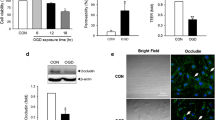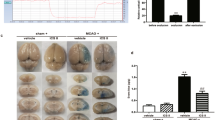Abstract
Brain microvascular endothelial cell (BMVEC) injury induced by ischemia–reperfusion (I/R) is the initial phase of blood–brain barrier (BBB) disruption, which results in a poor prognosis for ischemic stroke patients. Autophagy occurs in ischemic brain and has been shown to exhibit protective effects on endothelial cell against stress. However, the potential effects of BMVEC autophagy on BBB permeability during I/R and the mechanisms underlying these effects have yet to be elucidated. In the current study, we answered these questions by using chemical modulators of autophagy, including rapamycin and lithium carbonate acting, respectively, as mammalian target of rapamycin (mTOR)-dependent and mTOR-independent autophagy inducers and 3-methyladenine (3-MA) as an autophagy inhibitor. To mimic I/R injury, BMVECs were exposed to oxygen–glucose deprivation/reoxygenation (OGD/R), and a rat transient middle cerebral artery occlusion/reperfusion (MCAO/R) model was performed. All the drugs were given at 0.5 h before OGD/R or MCAO/R. First, enhancement of autophagy by rapamycin and lithium carbonate attenuated, whereas suppression of autophagy by 3-MA intensified BMVEC apoptosis and the high level of ROS induced by OGD/R. In addition, rapamycin and lithium carbonate pretreatments significantly reversed the decreased level of tight junction protein zonula occludens-1 (ZO-1) induced by OGD/R and promoted the distribution of ZO-1 on cell membranes. Finally, pretreatments with rapamycin and lithium carbonate reduced evans blue extravasation and brain water content in the ischemic hemisphere of the rat. In contrast, 3-MA pretreatment exerted opposite effects both in vitro and in vivo. These results may indicate a beneficial effect of BMVEC autophagy on BBB integrity during I/R injury.






Similar content being viewed by others
References
Date I, Takagi N, Takagi K, Tanonaka K, Funakoshi H, Matsumoto K, et al. Hepatocyte growth factor attenuates cerebral ischemia-induced increase in permeability of the blood-brain barrier and decreases in expression of tight junctional proteins in cerebral vessels. Neurosci Lett. 2006;407(2):141–5. doi:10.1016/j.neulet.2006.08.050.
Chen Y, Tachibana O, Hasegawa M, Xu R, Hamada J, Yamashita J, et al. Absence of tight junctions between microvascular endothelial cells in human cerebellar hemangioblastomas. Neurosurgery. 2006;59(3):660–70. doi:10.1227/01.NEU.0000223372.18607.D7. discussion -70.
Nathanson D, Mischel PS. Charting the course across the blood-brain barrier. J Clin Invest. 2011;121(1):31–3. doi:10.1172/JCI45758.
Shuvaev VV, Muzykantov VR. Targeted modulation of reactive oxygen species in the vascular endothelium. J Control Release Off J Control Release Soc. 2011;153(1):56–63. doi:10.1016/j.jconrel.2011.03.022.
Pun PB, Lu J, Moochhala S. Involvement of ROS in BBB dysfunction. Free Radic Res. 2009;43(4):348–64. doi:10.1080/10715760902751902.
Rizzo MT, Leaver HA. Brain endothelial cell death: modes, signaling pathways, and relevance to neural development, homeostasis, and disease. Mol Neurobiol. 2010;42(1):52–63. doi:10.1007/s12035-010-8132-6.
Liu X, Zhao J, Xu J, Zhao B, Zhang Y, Zhang S, et al. Protective effects of a benzoxazine derivative against oxidized LDL-induced apoptosis and the increases of integrin beta4, ROS, NF-kappaB and P53 in human umbilical vein endothelial cells. Bioorg Med Chem Lett. 2009;19(10):2896–900. doi:10.1016/j.bmcl.2009.03.070.
Xie Y, You SJ, Zhang YL, Han Q, Cao YJ, Xu XS, et al. Protective role of autophagy in AGE-induced early injury of human vascular endothelial cells. Mol Med Rep. 2011;4(3):459–64. doi:10.3892/mmr.2011.460.
Ravikumar B, Sarkar S, Davies JE, Futter M, Garcia-Arencibia M, Green-Thompson ZW, et al. Regulation of mammalian autophagy in physiology and pathophysiology. Physiol Rev. 2010;90(4):1383–435. doi:10.1152/physrev.00030.2009.
Renna M, Jimenez-Sanchez M, Sarkar S, Rubinsztein DC. Chemical inducers of autophagy that enhance the clearance of mutant proteins in neurodegenerative diseases. J Biol Chem. 2010;285(15):11061–7. doi:10.1074/jbc.R109.072181.
Wang Z, Shi XY, Yin J, Zuo G, Zhang J, Chen G. Role of autophagy in early brain injury after experimental subarachnoid hemorrhage. J Mol Neurosci MN. 2012;46(1):192–202. doi:10.1007/s12031-011-9575-6.
Zhao H, Ji Z, Tang D, Yan C, Zhao W, Gao C. Role of autophagy in early brain injury after subarachnoid hemorrhage in rats. Mol Biol Rep. 2013;40(2):819–27. doi:10.1007/s11033-012-2120-z.
Yu F, Wang Z, Tanaka M, Chiu CT, Leeds P, Zhang Y, et al. Posttrauma cotreatment with lithium and valproate: reduction of lesion volume, attenuation of blood-brain barrier disruption, and improvement in motor coordination in mice with traumatic brain injury. J Neurosurg. 2013;119(3):766–73. doi:10.3171/2013.6.JNS13135.
Yu F, Wang Z, Tchantchou F, Chiu CT, Zhang Y, Chuang DM. Lithium ameliorates neurodegeneration, suppresses neuroinflammation, and improves behavioral performance in a mouse model of traumatic brain injury. J Neurotrauma. 2012;29(2):362–74. doi:10.1089/neu.2011.1942.
van Vliet EA, Forte G, Holtman L, den Burger JC, Sinjewel A, de Vries HE, et al. Inhibition of mammalian target of rapamycin reduces epileptogenesis and blood-brain barrier leakage but not microglia activation. Epilepsia. 2012;53(7):1254–63. doi:10.1111/j.1528-1167.2012.03513.x.
Li WL, Yu SP, Chen D, Yu SS, Jiang YJ, Genetta T, et al. The regulatory role of NF-kappaB in autophagy-like cell death after focal cerebral ischemia in mice. Neuroscience. 2013;244:16–30. doi:10.1016/j.neuroscience.2013.03.045.
Yin L, Ye S, Chen Z, Zeng Y. Rapamycin preconditioning attenuates transient focal cerebral ischemia/reperfusion injury in mice. Int J Neurosci. 2012;122(12):748–56. doi:10.3109/00207454.2012.721827.
Takahashi T, Steinberg GK, Zhao H. Lithium treatment reduces brain injury induced by focal ischemia with partial reperfusion and the protective mechanisms dispute the importance of akt activity. Aging Dis. 2012;3(3):226–33.
Hua Q, Qing X, Li P, Li W, Hou J, Hu J, et al. Brain microvascular endothelial cells mediate neuroprotective effects on ischemia/reperfusion neurons. J Ethnopharmacol. 2010;129(3):306–13. doi:10.1016/j.jep.2010.03.024.
Xie R, Li X, Ling Y, Shen C, Wu X, Xu W, et al. Alpha-lipoic acid pre- and post-treatments provide protection against in vitro ischemia-reperfusion injury in cerebral endothelial cells via Akt/mTOR signaling. Brain Res. 2012;1482:81–90. doi:10.1016/j.brainres.2012.09.009.
Wang L, Dong Z, Huang B, Zhao B, Wang H, Zhao J, et al. Distinct patterns of autophagy evoked by two benzoxazine derivatives in vascular endothelial cells. Autophagy. 2010;6(8):1115–24.
Kim EC, Meng H, Jun AS. Lithium treatment increases endothelial cell survival and autophagy in a mouse model of Fuchs endothelial corneal dystrophy. Br J Ophthalmol. 2013;97(8):1068–73. doi:10.1136/bjophthalmol-2012-302881.
Szliszka E, Czuba ZP, Bronikowska J, Mertas A, Paradysz A, Krol W. Ethanolic extract of propolis augments TRAIL-induced apoptotic death in prostate cancer cells. Evid Based Complement Alternat Med eCAM. 2011;2011:535172. doi:10.1093/ecam/nep180.
Chauhan A, Sharma U, Jagannathan NR, Reeta KH, Gupta YK. Rapamycin protects against middle cerebral artery occlusion induced focal cerebral ischemia in rats. Behav Brain Res. 2011;225(2):603–9. doi:10.1016/j.bbr.2011.08.035.
Zakeri M, Afshari K, Gharedaghi MH, Shahsiah R, Rahimian R, Maleki F, et al. Lithium protects against spinal cord injury in rats: role of nitric oxide. J Neurol Surg Part A Central Eur Neurosurg. 2013. doi:10.1055/s-0033-1345098.
Liu JJ, Zhang Y, Guang WB, Yang HZ, Lin DJ, Xiao RZ. Ponicidin inhibits monocytic leukemia cell growth by induction of apoptosis. Int J Mol Sci. 2008;9(11):2265–77. doi:10.3390/ijms9112265.
Shen SL, Zhu J, Li M, Zhao BX, Miao JY. Synthesis of ferrocenyl pyrazole-containing chiral aminoethanol derivatives and their inhibition against A549 and H322 lung cancer cells. Eur J Med Chem. 2012;54:287–94. doi:10.1016/j.ejmech.2012.05.008.
Jiang S, Xia R, Jiang Y, Wang L, Gao F. Vascular endothelial growth factors enhance the permeability of the mouse blood-brain barrier. PLoS ONE. 2014;9(2):e86407. doi:10.1371/journal.pone.0086407.
Urbanek T, Kuczmik W, Basta-Kaim A, Gabryel B. Rapamycin induces of protective autophagy in vascular endothelial cells exposed to oxygen-glucose deprivation. Brain Res. 2014;1553:1–11. doi:10.1016/j.brainres.2014.01.017.
Lou JN, Mili N, Decrind C, Donati Y, Kossodo S, Spiliopoulos A, et al. An improved method for isolation of microvascular endothelial cells from normal and inflamed human lung. In Vitro Cell Dev Biol Anim. 1998;34(7):529–36. doi:10.1007/s11626-998-0112-z.
Kabeya Y, Mizushima N, Ueno T, Yamamoto A, Kirisako T, Noda T, et al. LC3, a mammalian homologue of yeast Apg8p, is localized in autophagosome membranes after processing. EMBO J. 2000;19(21):5720–8. doi:10.1093/emboj/19.21.5720.
Li H, Huang S, Wang S, Zhao J, Su L, Zhao B, et al. Targeting annexin A7 by a small molecule suppressed the activity of phosphatidylcholine-specific phospholipase C in vascular endothelial cells and inhibited atherosclerosis in apolipoprotein E(-)/(-) ice. Cell Death Dis. 2013;4:e806. doi:10.1038/cddis.2013.317.
Zhang Q, Gould LJ. Hyperbaric oxygen reduces matrix metalloproteinases in ischemic wounds through a redox-dependent mechanism. J Invest Dermatol. 2014;134(1):237–46. doi:10.1038/jid.2013.301.
Acknowledgments
This work was supported by grants from the National Natural Science Foundation of China (No. 81171105, 81271300, and 81371279), Jiangsu Province’s Outstanding Medical Academic Leader program (No. LJ201139), the National Key Technology R&D program for the 12th Five-year plan of the People’s Republic of China (2011BAI08B05, 2011BAI08B06, and 2014BAZ04810), and grants from Scientific Department of Jiangsu Province (No. BL2014045) and Suzhou Government (No. LCZX201301, SZS201413 and SYS201332).
Conflict of Interest
All the authors, including Haiying Li, Anju Gao, Dongxia Feng, Yang Wang, Li Zhang, Yonghua Cui, Bo Li, Zhong Wang, and Gang Chen, declare that they have no conflicts of interest in the research. All institutional and national guidelines for the care and use of laboratory animals were followed.
Author information
Authors and Affiliations
Corresponding authors
Additional information
Haiying Li and Anju Gao contributed equally to this work.
Rights and permissions
About this article
Cite this article
Li, H., Gao, A., Feng, D. et al. Evaluation of the Protective Potential of Brain Microvascular Endothelial Cell Autophagy on Blood–Brain Barrier Integrity During Experimental Cerebral Ischemia–Reperfusion Injury. Transl. Stroke Res. 5, 618–626 (2014). https://doi.org/10.1007/s12975-014-0354-x
Received:
Revised:
Accepted:
Published:
Issue Date:
DOI: https://doi.org/10.1007/s12975-014-0354-x




